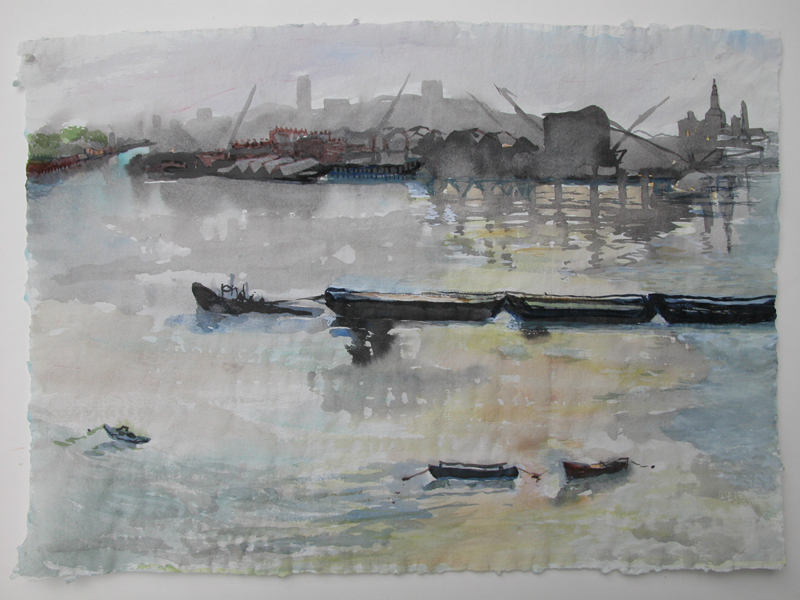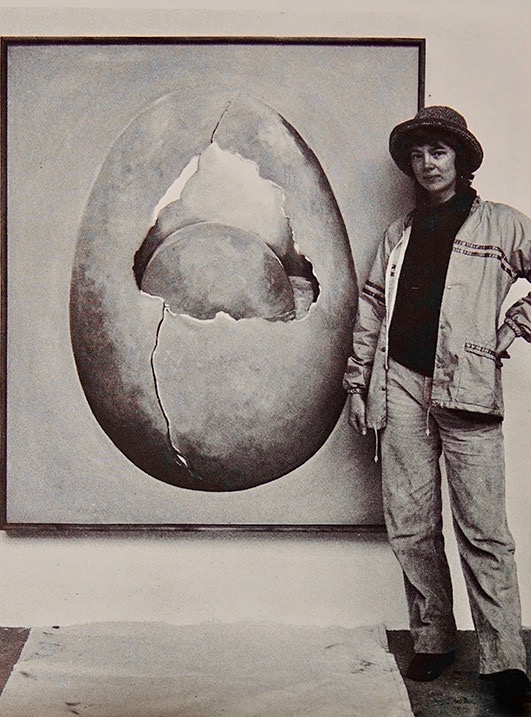Mary Jo Major was born in Edmonton, Alberta and since then she has traveled widely. In Australia she taught and studied painting at the Melbourne Institute of Technology. In Indonesia she learned the art of batik, then studied at the Ècole des Beaux Arts, Aix-en-Provence, subsequently earning her BFA at Concordia University, Montreal, Quèbec. In 1992 she received her MFA from the University of Calgary.
Mary Jo Major has achieved distinction as a painter and printmaker. Her work has been widely collected in such places as The New York Public Library, the Glenbow Museum (Calgary, Canada), the Whitechapel Library (London, England), the Canada Council Art Bank, and the University of Calgary Special Collections.
My Career So Far
After completing a Bachelor of English from the University of Calgary I taught school and took evening classes in art, learning painting at Victoria Technical Institute in Melbourne, Australia. I was motivated to learn the craft of painting by working outdoors, capturing a variety of landscapes. I usually exchanged these watercolours for hospitality of friends and fellow travellers. I continued to take classes on my travels, learning batik in Indonesia and painting at the Ecole des Beaux Arts in Aix-en-Provence, France.
While teaching in Montreal, Quebec I studied painting at the Ecole des Beaux Arts and Concordia University. I completed a Bachelor of Fine Arts at Concordia University where I was privileged to learn advanced etching and lithography techniques from the American visiting professor, Jack Damer, whose teachings became an early gift for my future career.
Drawn to the possibility of earning my living in the art world, I took my new skills in printmaking and left Montreal for London, England. I found Skye Editions on the south bank of the River Thames, just east of London’s Tower Bridge. Alan Cox was hiring printers for plate lithography on hand powered presses. I printed for individual artists, some sponsored by Christie’s Fine Art Editions, The Tate Gallery and other galleries. Jim Dine, Howard Hodgkins, Alexis Hunter and numerous other British and American artists worked at Skye looking out over the tidal river and ever-changing drama of clouds rolling in full of rain. We were close enough to see the troops and guests on the deck of Queen Elizabeth’s Royal Yacht Britannia sail by celebrating her Silver Jubilee in 1977.

The American poet Faith Gillespie and I created Omlette Press. We bought wood type and set up our Van der Cook type and woodblock press and a Rochat etching press in my AIR and SPACE studio at Phipp St.,in the borough of Shoreditch. Our first publication was a limited edition book of Faith’s poems and my etchings, titled "Poemprints". We hand-set the type using fonts that we acquired during the great sell-off of Fleet Street newspaper printing equipment as the papers moved to digital production.
"Poemprints" was juried into the exhibition "British Artists’ Books 1970-1983". The books were laid on tables in the gallery and people were required to put the cotton gloves on before opening the books and turning the pages. This show brought together an impressive list of 45 luminaries of the art world including Patrick Caulfield, Eduardo Paolozzi, John Piper, and Elizabeth Frink, to name a few. It was inspiring to be included in this esteemed circle of famous artists.
As the London Docklands were relocating to Canary Wharf their vast Victorian built tea warehouses were emptied and rented temporarily to artists. Working in Faith Gillespie’s New Crane Wharf H4 was a dream come true for me. I was able to sit on a small balcony previously designed to off-load cargo directly from the ship, and listen to the barges and exotic river craft while painting the changing light in watercolours. I also brought copper plates prepared with hard ground wax and drew images by hand using a diamond point tool.
Two of these etchings of Thames Barges were juried into the prestigious Whitechapel Open Exhibition in 1984. A watercolour of the River Thames won a purchase award from The London Borough of Tower Hamlets Library, juried by the Whitechapel Gallery. The following year I was awarded the Tower Hamlets Artist Merit Award.

I was thrilled to be invited to exhibit my work at Canada House, Trafalgar Square in 1983. As is my custom I chose to show a variety of mediums as evidenced in the title of the exhibition: Paintings Prints Textiles, 1983. year.

Every year H4 New Crane Wharf participated in a group exhibition called Wapping Open Studios after the name of the location, the borough of Wapping. The catalogues from 1981-1985 were effective publicity, featured each artist on a full page, and brought the public out in large numbers to wander through the impressive warehouses.
Eventually the economy gathered strength in London and warehouse studios were sold to developers. Artists returned to their roots in rural England and Christian Grandjean and I set off for life in Alberta.
I was privileged to be accepted for the masters program at the University of Calgary where I studied with distinguished faculty, including William Laing, Marcia Perkins, and Peter Deacon. The subject matter of my thesis was motherhood, my graduate exhibition at the Nickle Gallery was inspired by family life. Our daughters, from age 2 to 4, thought it was great fun to roll around on waxed copper plates from which I printed images.
During my 2 years in the Masters of Fine Arts program I won a scholarship to study at the New York Center for Book Arts. Working with paper I was able to explore the new capacities of computers to produce images, hand-sew pages together and make archival boxes to hold precious documents and momentos.
After completing my MFA at University of Calgary I set up Omlette Press in our converted garage and continued to print etchings in limited editions. Germaine Arnaktauyok, a renowned artist from Canada’s Inuit community brought her drawings of the orally transmitted legends she had learned from her grandparents, originally from Baffin Island. We translated the drawings into etchings and printed them for Arts Induvik.
Virginia Christopher Galleries sent the Woodland Cree artist Fred Macdonald to print his depictions of tribal stories and legends. We interpreted his imagery of tribal legends and customs into the etching medium and this work was presented in a commemoration of Wolf Creek in northern Alberta. Two of my botanical etchings were also chosen for the commemoration. In the interest of authenticity Virginia and I had made a trek to the area to find and pick authentic weeds and flowers found growing in swamps and muskeg.
I continued to work in my converted garage studio in Altadore, Calgary until 2000 when we left for a residency in Pittsburgh, Pennsylvania. The highlight of this trip was the honour of having my work accepted by the jury of the renowned Carnegie Mellon Associated Artists of Pittsburgh 91st Annual Exhibition in 2001. I was to receive an award from the Maggie Milono Memorial Award for my painting entitled "The Path".

Since 2002 I have worked in my home studio in Charleswood, Calgary. Over time I evolved from oil to acrylic painting. My latest series, "The Geometry of Light" is a departure from landscape work, favouring memories of visual incidents, feelings, and associations. It is not only the forms in nature that inspire me but the light and wind, the heat of summer and the freezing cold. The focus of attention varies in the way one colour is affecting another or on the brushstrokes that define the space. I find my way with each rectangle and colour as they move toward the edges of the canvas implying that the painting continues beyond the canvas’s physical square. A deeper resonance is the allusion to inner and outer space, to images and patterns in batik, weaving, natural forms seen under a microscope, tight patterns reminiscent of fractals, and images derived from biology and astronomy. My view of nature is simultaneously real and imagined which results in unlimited possibilities for the collaboration between myself and the viewer in assigning meaning to the painting. All that is required of the viewer is to spend time looking deeply.

Current Events
Saturday, July 5th 2025: Ruberto Ostberg Gallery Pancake Breakfast
During the run of its CONNECTIONS 2025 show [June 13 - August 31, 2025] Ruberto Ostberg Gallery continues its celebration of the Calgary Stampede again this year with its traditional Pancake Breakfast on July 5th. This helps neighbours and visitors enjoy this special season together and meet and mingle with our gallery artists.

June 2025: One of my paintings is included in the Connections 2025 group show at Ruberto Ostberg Gallery

Since 2004, the Ruberto Ostberg Gallery has offered a welcoming space for original contemporary art. CONNECTIONS celebrates artistic diversity by bringing together creators at all stages of their careers in a vibrant and cohesive group show. This exhibition emphasizes the value of artists learning from one another, building relationships that inspire growth and collaboration. It also strengthens ties between artists and the wider community, fostering a deeper appreciation for the role of art in everyday life.

Purchase Information
Please contact me by email to enquire about purchase of any artworks not marked SOLD.
Prices are in very reasonable Canadian dollars and shipping easily arranged.
Thank you for your interest in my work.
Links
External: Email - Mary Jo Major (maryjo@maryjomajor.ca)
External: Website - Mary Jo Major
External: Instagram - Mary Jo Major (mjmajor)
Photographs of artwork and portrait photos by Christian Grandjean.
